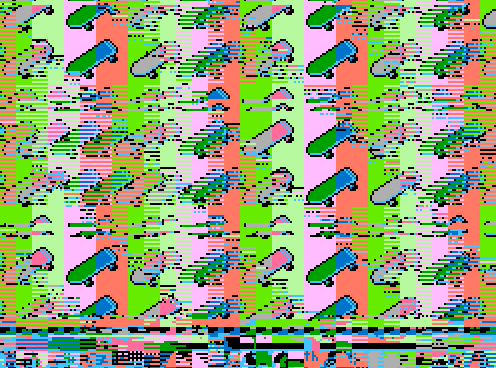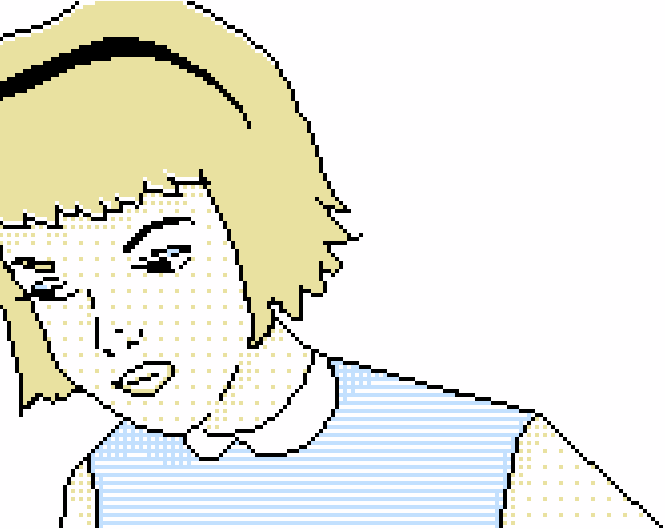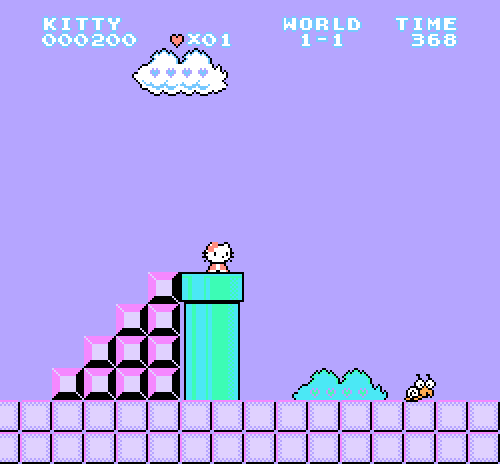Remaking the videogame canon with Rachel Weil

Header illustration by Jordan Rosenberg
///
There is no Super Mario. The iconic pudgy plumber never existed. The Mushroom Kingdom’s skies were always this light shade of lavender. The hearts that sit rosily at the center of each cloud and bush are eternal. Forget what you know: Hello Kitty Land saved Nintendo from the brink of financial collapse, and not Donkey Kong or Super Mario Bros.
This alternative, pink-laced Polly Pocket dimension is the basis of Rachel Simone Weil’s hyper-feminine videogame allohistory. It’s from here that she designs and creates her own custom software, hacking together 8-bit nostalgia with girly symbols for love and femininity. Weil revisits videogame history, particularly of the 80s and 90s, to reimagine what it could have been if it were without the dominant boyish rhetoric. What would videogames have looked like if they were made to appeal to her as a child? And what if boys didn’t have to enjoy pink hearts, ribbons, and pastel colors only as a guilty pleasure?
Weil’s exhibition at the Visual Arts Center in Texas put Barbie games in a glass display. She also recreated a vintage girl’s bedroom: a plastic ballet dancer, a Judy Blume book laid across a Nintendo Entertainment System, all of it gathered around a TV dressed up with little pom-poms and hot pink fluff. She founded the FEMICOM Museum in 2012, which is a physical and digital collection of feminine video games, software, and electronic toys. Weil has also created NES games under the name “Party Time! Hexcellent!,” such as Electronic Sweet-N-Fun Fortune Teller and TRACK+FEEL II, both of which feature passivity, emotion, and romance as central conceits. Once, she even gave Mega Man II a girly makeover with a typeface ripped from the NES Barbie game.

Her creative investigation into this gendered aesthetic and its role, or lack thereof, in computer history is a personal one. Weil describes her childhood self as a girly-girl. This was an identity that she practiced not only through her material possessions—frilly dresses and Barbie dolls—but also in her enactment of what she understood femininity to be at the time. This was largely derived from cartoons promoting friendship and love, particularly Strawberry Shortcake; the typical motifs of weddings, love hearts, and flowers signposted feminine spaces and interests for her to follow.
“Why would someone say that pink is stupid or Barbies are the worst?”
While these inclinations consumed Weil as a child, she also engaged in what were considered “boyish hobbies,” too. She loved collecting baseball cards—”I had binders of sports cards,” she told me—and was absolutely obsessed with Teenage Mutant Ninja Turtles. Other formative fascinations included the gross-out toys of the ’90s: the disgusting projectiles of Blurp Balls, the revolting consumption of Doctor Dreadful’s Food Lab, and the questionable white sticky liquid of The Oozinator. Also, while rarely having access herself, computers and videogames were always a side glanced curiosity for the young Weil.
“Videogames did seem to be ‘boys’ toys’ in my estimation: competitive, tough, that in-your-face brand of ‘extreme’ that seems cute now but was at least a little edgy at the time,” Weil said.
In the ’90s, at least in terms of how they were marketed (and sometimes designed), video games belonged to the same realm as the Andre Agassi Mountain Dew advert, as the in-your-face “no rules” illustrated magazine adverts, and not forgetting the “next level” SEGA Game Gear commercial. Teenage testosterone infiltrated the mainstream through aggressive shows of display that encouraged pushing either your body or your mind to its manly limits. It was all boys riding bikes, men jumping off cliffs, scrunched-up and fierce-looking faces mid-coitus with their own apparent might. Likewise, the NES was marketed in North America as, according to Weil, an “advanced, precise, powerful, and largely masculine” machine. Rarely did girls hold the controllers in the print or TV adverts for the NES, and its recurring subtleties like this that surrounded video game consoles and culture that Weil sees as affecting who was “formally or informally permitted to play” them.

Still, outside of videogames, none of this edgy, ass-kicking marketing fazed Weil during her youngest years. This is most likely due to the social pressure telling her to stick to a single side—either her girly nature or her boyish interests—not being present at that point in her life. “In kindergarten, when asked what I wanted to be when I grew up, I replied, “My mom and Bo Jackson,”” Weil recalls. This would change dramatically as Weil caved into those pressures as she grew up. By her early teens she was the “thrift-store shopping, Telecaster-playing, punk rock anti-girl.” Weil’s reasoning for this rebellion at the time is revealing: she had determined that if she wanted to be taken seriously then she needed to act more like a boy. Hence, the “girls are dumb,” “pink is stupid,” “Barbies are the worst,” attitude.
Weil looks back on these years and how she acted with a critical mind and an effort to not only understand herself back then but to challenge the very idea that someone would reject any association with femininity. “Why would someone say that pink is stupid or Barbies are the worst? Why would a teenage girl think girls are dumb? What’s wrong with love and friendship?” These are the types of questions that Weil scrutinizes through her work, and believes that doing so will benefit all of our relationships with social values, gendered and otherwise.
Understand that, while Weil would call her work feminist, she also challenges a lot of popular feminist attitudes. She’s especially critical towards ideas around stereotypes and dismantling them, and the idea that female characters should always be strong to inspire mimesis of this in young girls. Her work puts value on the feminine in a way that makes it available to everyone, so that we can all simultaneously criticize and enjoy it. She would like to see a world in which girly interests aren’t deliberately separated from the mainstream through categorization like “chick flicks” and “chick lit,” which quite explicitly informs us of the idea that it is culturally inferior.
she loves the idea of destabilizing game history
“In dismantling what we perceive as ‘negative’ stereotypes, we too hastily dismantle representations of sweetness, generosity, friendship, love, patience, selflessness—practices important in equal measure to all of humanity,” Weil said. “Here, I think there is exceedingly great opportunity for videogames to take part in this conversation.”
Why videogames? Why not—they’re the biggest-selling entertainment in the world right now, and therefore a prime medium to be used to connect with a lot of people. With videogames having gone global and gotten so popular, with experimental and casual iterations reaching out to new audiences, isn’t it important that we challenge its form, how it’s marketed, and what it achieves? Weil seems to think so, and her chosen target is game history; she loves the idea of destabilizing and calling it into question. She wants to look back twenty years and see what it was that inspired people who played games in their youth to do so.
It’s possible to perceive Weil’s creations as being destructive and deliberately caustic. Replacing a cultural icon such as Mario with Hello Kitty might seem provocative. Her fuzzy glitch art and monstrous morphing of the female body in her pixel art (particularly this one) may further this reading. It’s a low-key celebration of technological error—perhaps the destruction of those hard-edged masculine machines—rendered in pink and purple, sprouting flowers and candy pink fonts; as if the destructive expressions of a collective girly conscience come to manipulate, fragment, and modify the norm in its own image. Then, of course, she talks about dismantling video game history in order to bring it into question and to spread the feminine.
This is how a lot of feminist critiques of gaming are read; as an effort to demonize and disregard popular games for their flaws. It’s a trend that Weil is troubled by. This is why she aims to participate in feminist critique in a way that, hopefully, avoids that reading. She adds to videogame culture without taking anything away. She is creative in order to be critical.
“All media and entertainment are problematic in some way, and that’s no reason to discard or disown them,” Weil says. “Let’s celebrate our favorite games and good memories but remember to cultivate critical eyes and open minds, too.”

This approach is why, if you ask Weil directly, she’ll disagree that her work is only about girls and women. She’s primarily interested in how femininity in gaming touches us all. Men can and do enjoy feminine games, after all, even if it’s in secret, while their sister is out with her friends. (I did this as a child, playing a Barbie vet game on our shared PC that was originally bought specifically for my sisters to play). What Weil argues is that our ideas of cultural legitimacy, those that mark girly and feminine interests down, are fundamentally flawed. Her efforts really only come down to one question: “How might game designers help to legitimize femininity in gaming?”
FEMICOM is one of way of working towards finding this answer. Over the course of her studies, Weil found that the way that femininity is often ridiculed by reviewers and game enthusiasts, a passive disinterest in the “accurate preservation of feminine games” has occurred. So she founded FEMICOM as a way to counteract that, for there to be a central repository for what she aims to be reliable and accurate information about girly games. “My hope is that FEMICOM can inspire retrospectives on Barbie games, art prints inspired by Crystal’s Pony Tales, contemporary spiritual sequels to Theresa Duncan’s 1990s CD-ROM games, and other cultural works based on these games that have otherwise gone underrepresented in game cultures,” Weil said.
FEMICOM doesn’t stand alone. Sure, it’s meant to be the center of the celebration and preservation of femininity and girly games. But it complements existing game databases and community-based history-making practices. The last thing that Weil would want is for FEMICOM to be the end-all of its entire subject. In the future, she hopes to take the collection at the museum to the public so others not familiar with these obscure and ignored videogames can play them. She’s also hoping to produce written work to fully catalogue FEMICOM, as well as finally put the knowledge that she’s gained in searching for and studying these games down in a more permanent place than her head.
All that said, Weil’s hunt for the girly games that history has chosen to forget will not end. She will continue to preserve, celebrate, as well as contribute her own creative endeavors to the ultra-feminine aesthetic in hopes that, one day, we can all enjoy it without the secrets or the shame.



